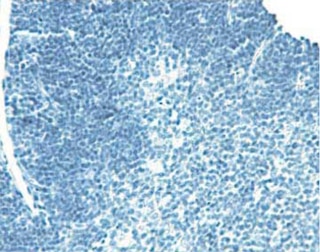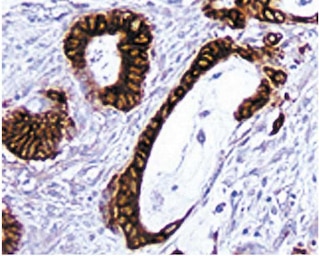Old Browser
This page has been recently translated and is available in French now.
Looks like you're visiting us from {countryName}.
Would you like to stay on the current country site or be switched to your country?




Immunohistochemical staining of macrophages. The formalin-fixed paraffin-embedded sections of normal mouse lung were stained with M3/84 mAb (left panel) or R3-34 mAb (isotype control, right panel). Macrophages are identified by the brown labeling of their cell -surface membranes.


BD Pharmingen™ Purified Rat Anti-Mouse CD107b

Regulatory Status Legend
Any use of products other than the permitted use without the express written authorization of Becton, Dickinson and Company is strictly prohibited.
Preparation And Storage
Recommended Assay Procedures
Immunohistochemistry: The M3/84 antibody is recommended to test for immunohistochemical staining of paraffin sections or zinc-fixed paraffin sections. No pretreatment of the formalin-fixed sections is required. Tissues tested were mouse lung, spleen, and thymus. The antibody stains tissue macrophages. The isotype control recommended for use with this antibody is purified rat IgG1 (Cat. No. 559072). For optimal indirect immunohistochemical staining, the M3/84 antibody should be titrated (1:10 to 1:50 dilution) and visualized via a three-step staining procedure in combination with biotinylated anti-rat IgG1/2a (multiple adsorbed) (Cat. No. 550325) as the secondary antibody Streptavidin-HRP (Cat. No. 550946) together with the DAB detection system (Cat. No. 550880). A detailed protocol of the immunohistochemical procedure can be found on our web site at www.bdbiosciences.com/support/resources.
Product Notices
- Since applications vary, each investigator should titrate the reagent to obtain optimal results.
- An isotype control should be used at the same concentration as the antibody of interest.
- Caution: Sodium azide yields highly toxic hydrazoic acid under acidic conditions. Dilute azide compounds in running water before discarding to avoid accumulation of potentially explosive deposits in plumbing.
- Source of all serum proteins is from USDA inspected abattoirs located in the United States.
- This antibody has been developed for the immunohistochemistry application. However, a routine immunohistochemistry test is not performed on every lot. Researchers are encouraged to titrate the reagent for optimal performance.
- Sodium azide is a reversible inhibitor of oxidative metabolism; therefore, antibody preparations containing this preservative agent must not be used in cell cultures nor injected into animals. Sodium azide may be removed by washing stained cells or plate-bound antibody or dialyzing soluble antibody in sodium azide-free buffer. Since endotoxin may also affect the results of functional studies, we recommend the NA/LE (No Azide/Low Endotoxin) antibody format, if available, for in vitro and in vivo use.
- Please refer to www.bdbiosciences.com/us/s/resources for technical protocols.
Companion Products






The M3/84 monoclonal antibody specifically binds to CD107b which is also known as Mac-3, Lysosome-associated membrane protein 2 (LAMP-2/Lamp2/Lamp II), and Lysosomal membrane glycoprotein type B (LGP-B). CD107b is a single-pass type I transmembrane glycoprotein that constitutes a major integral membrane protein of lysosomes and may play a role in lysosomal function. CD107b is also expressed on the surface of mouse mononuclear phagocytes. Surface expression of the 92-110-kDa glycoprotein antigen increases during differentiation of monocytes to activated macrophages and may play a role in adhesion. The M3/84 mAb can detect CD107b antigen on tissue macrophages, thioglycollate-elicited peritoneal macrophages, and some myeloid cell lines, but not on lymphocytes or monocytes. In the bone marrow, very few cells display CD107b antigen on the surface, but a large proportion express cytoplasmic CD107b. The M3/84 antibody has also been reported to stain dendritic cells and endothelium in sections of thymus (both medulla and cortex), lymph nodes, spleen (white pulp), and gut-associated lymphoid tissue.
Development References (6)
-
Chen JW, Murphy TL, Willingham MC, Pastan I, August JT. Identification of two lysosomal membrane glycoproteins. J Cell Biol. 1985; 101(1):85-95. (Clone-specific: Immunoprecipitation). View Reference
-
Flotte TJ, Springer TA, Thorbecke GJ. Dendritic cell and macrophage staining by monoclonal antibodies in tissue sections and epidermal sheets. Am J Pathol. 1983; 111(1):112-124. (Clone-specific: Immunohistochemistry). View Reference
-
Ho MK, Springer TA. Tissue distribution, structural characterization, and biosynthesis of Mac-3, a macrophage surface glycoprotein exhibiting molecular weight heterogeneity. J Biol Chem. 1983; 285(1):636-642. (Clone-specific: Immunoprecipitation). View Reference
-
Ralph P, Ho MK, Litcofsky PB, Springer TA. Expression and induction in vitro of macrophage differentiation antigens on murine cell lines. J Immunol. 1983; 130(1):108-114. (Clone-specific: Immunoprecipitation). View Reference
-
Springer TA. Monoclonal antibody analysis of complex biological systems. Combination of cell hybridization and immunoadsorbents in a novel cascade procedure and its application to the macrophage cell surface. J Biol Chem. 1981; 256(8):3833-3839. (Immunogen: Immunoprecipitation). View Reference
-
Walker EB, Akporiaye ET, Warner NL, Stewart CC. Characterization of subsets of bone marrow-derived macrophages by flow cytometry analysis. J Leukoc Biol. 1985; 37(2):121-136. (Biology). View Reference
Please refer to Support Documents for Quality Certificates
Global - Refer to manufacturer's instructions for use and related User Manuals and Technical data sheets before using this products as described
Comparisons, where applicable, are made against older BD Technology, manual methods or are general performance claims. Comparisons are not made against non-BD technologies, unless otherwise noted.
For Research Use Only. Not for use in diagnostic or therapeutic procedures.
Report a Site Issue
This form is intended to help us improve our website experience. For other support, please visit our Contact Us page.